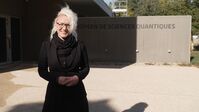 KIT involved in the European Quantum Center KIT involved in the European Quantum CenterProfessor Anja Metelmann conducts cross-border research with her bridging professorship on quantum computing in Karlsruhe and Strasbourg. Mehr erfahren20.10.2023 |
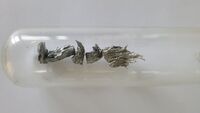 Rare Earth Compounds for High-tech Applications Rare Earth Compounds for High-tech ApplicationsNew Collaborative Research Center CRC 1573 “4f for Future” Focuses on Molecular Compounds with Extraordinary Properties. More |
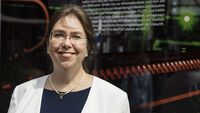 Anke-Susanne Müller wins State Research Prize Anke-Susanne Müller wins State Research Prize |
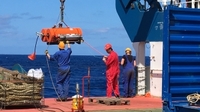 Plate Tectonics: How Water Causes Earthquakes and Volcanism Plate Tectonics: How Water Causes Earthquakes and VolcanismInternational research team studied relationships in the Lesser Antilles. Publication in Nature More25.06.2020 |
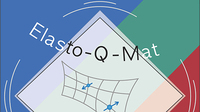 New Quantum Materials New Quantum MaterialsInteractions between mechanical and electronic properties offer significant application potential. More05.06.2020 |
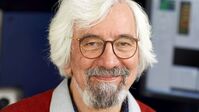 Kavli Prize for Pioneers of Electron Microscopy Kavli Prize for Pioneers of Electron MicroscopyMaximilian Haider, Harald Rose, Knut Urban and Ondrej Krivanek are awarded the Kavli Prize 2020 More03.06.2020 |
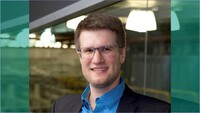 Frank Sacherer Prize goes to KIT Frank Sacherer Prize goes to KITJohannes Steinmann receives the international EPS-AG/IPAC Frank Sacherer Prize for research in the context of his doctoral thesis at IBPT. More |
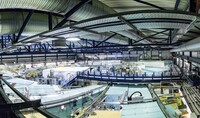 KARA Supports Corona Research KARA Supports Corona ResearchThe Karlsruhe Research Accelerator (KARA) is another infrastructure facility of KIT that conducts Corona-related research. More23.04.2020 |
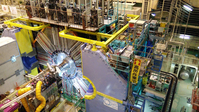 In Search of the Z‘ Boson In Search of the Z‘ BosonKIT scientists are involved in the Belle II accelerator experiment, which has now published first results. More14.04.2020 |
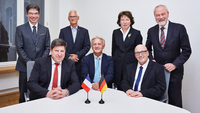 French Embassy Counsellor visits KIT French Embassy Counsellor visits KITOn March 5, 2020, Mr. Pascal Revel, Counsellor for Science and Technology of the French Embassy in Germany, and Mr. Hervé Martin, University Tutor for Cooperation in Science in Bavaria and Baden-Württemberg, visited KIT for the first time. More |
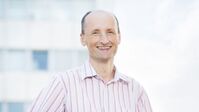 Science Award of the Hector Foundation Goes to KIT Physicist Science Award of the Hector Foundation Goes to KIT PhysicistWolfgang Wernsdorfer receives 150 000 Euros in prize money for his contributions to quantum computing. More04.02.2020 |
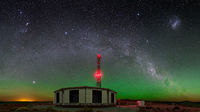 20 Years Pierre Auger Observatory 20 Years Pierre Auger Observatory |
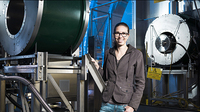 KIT Physicist Ranked in the "Top 40 under 40" KIT Physicist Ranked in the "Top 40 under 40"Capital business magazine ranks Kathrin Valerius among the “Young Elite 2019” in the category of “Science and Society.” More28.11.2019 |
-Magali-Hauser_DAAD_180x101_rdax_200x112s.jpg) Kick-Off for new German-Argentinian double degrees Kick-Off for new German-Argentinian double degreesA kick-off meeting for new double degrees took place at KIT Mid of October. KIT now has three German-Argentinian double degrees, including a Double Doctoral degree in Astrophysics (DDAp). More |
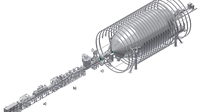 New Limit of the Neutrino Mass New Limit of the Neutrino MassThe KATRIN Karlsruhe Tritium Neutrino Experiment limits the mass of neutrinos to less than 1 eV. More16.09.2019 |
 Innovative Methods for Non-smooth Problems Innovative Methods for Non-smooth Problems |
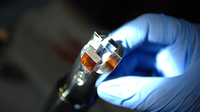 Accelerator Technology of Tomorrow Accelerator Technology of TomorrowFederal Ministry of Education and Research funds KIT accelerator research with around three million euros. More21.08.2019 |
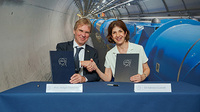 KIT and CERN Expand Collaboration KIT and CERN Expand CollaborationCloser cooperation in the field of advanced accelerator technologies - "Declaration of Intent" signed. More16.08.2019 |
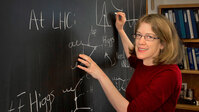 Julius Wess Prize Goes to Sally Dawson Julius Wess Prize Goes to Sally DawsonScientist receives award for theoretical descriptions of processes in particle accelerators. More22.07.2019 |
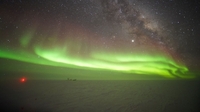 Antarctica: Neutrino experiment is growing Antarctica: Neutrino experiment is growingIceCube is being expanded with the participation of KIT to measure neutrinos with unprecedented accuracy. More16.07.2019 |
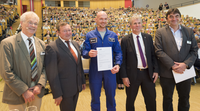 A Glimpse into Space: Alexander Gerst Inspires at KIT A Glimpse into Space: Alexander Gerst Inspires at KITThe German ESA astronaut received an honorary doctorate and spoke about his missions in space. Video available. More12.07.2019 |
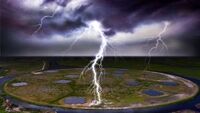 Nature: When Lightning Strikes – The LOFAR Radio Telescope Is Watching Closely Nature: When Lightning Strikes – The LOFAR Radio Telescope Is Watching CloselyLightning still is a poorly understood phenomenon – LOFAR Radio Telescope measures so far unknown structures and discharge processes – Research at KIT has laid technological foundations. More |
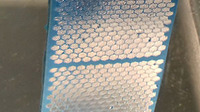 Ships Glide in an Envelope of Air Ships Glide in an Envelope of AirAward of the Federal Ministry of Education and Research goes to project for research into bionic ship coatings. More27.03.2019 |
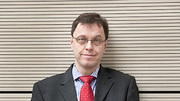 Martin Wegener is New Member of acatech Martin Wegener is New Member of acatechDie Deutsche Akademie der Technikwissenschaften hat 28 herausragende Forschende aufgenommen. Link_more |
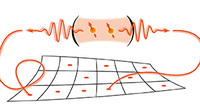 Beginnings of Quantum Communication Beginnings of Quantum CommunicationThe Federal Ministry of Education and Research funds cooperation project on fast and tap-proof communication. More20.12.2018 |
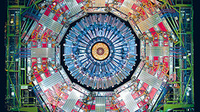 Millions of Funding for Elementary Particle Research Millions of Funding for Elementary Particle ResearchBMBF funds experimental research into fundamental building blocks of matter with EUR 7.6 million. More17.12.2018 |
 Leibniz Prize for KIT Scientist Leibniz Prize for KIT Scientist |
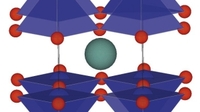 Science: High Pressure Arranges Electrons Science: High Pressure Arranges Electrons |
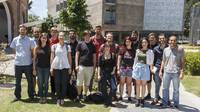 Inauguration of the new Helmholtz International Research School in Buenos Aires Inauguration of the new Helmholtz International Research School in Buenos AiresOn November 20, 2018 the inauguration of the |
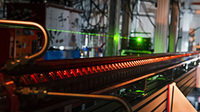 Accelerators for Science and Medical Research Accelerators for Science and Medical ResearchHelmholtz Association funds project for accelerator technologies with nearly 30 million euros. More21.11.2018 |
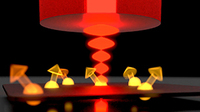 Multi-functional Quantum Bits for Future Computers Multi-functional Quantum Bits for Future Computers |
 New KIT Mathematics Center Established New KIT Mathematics Center Established |
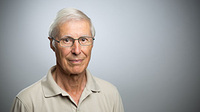 Peter Würfel Receives Becquerel Prize 2018 Peter Würfel Receives Becquerel Prize 2018The European Commission honors the physicist's outstanding contributions to the theory of photovoltaics. More30.08.2018 |
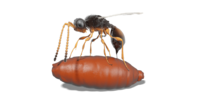 Parasites in Fossil Fly Pupae Parasites in Fossil Fly PupaeWasps in several-million-year-old pupae detected by synchrotron X-ray microtomography. More28.08.2018 |
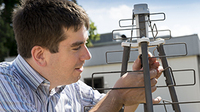 Antennas for Cosmic Rays Antennas for Cosmic Rays |
_rdax_180x101_rdax_200x112s.jpg) Best grade for Young Investigator Group Best grade for Young Investigator GroupCouncil for Research and Promotion of Young Scientists (CRYS) confirms extraordinary success of the Helmholtz Young Investigator Group "Analysis of KATRIN Data to Measure the Neutrino Mass and Search for New Physics“. More |
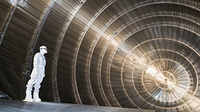 Neutrinos Weighed by the World´s Most Precise Scale Neutrinos Weighed by the World´s Most Precise Scale |
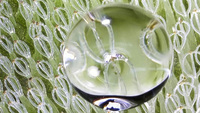 Air Coating for Ships Air Coating for ShipsThe coating reduces the frictional resistance of ships and makes them glide more easily through the water. More02.05.2018 |
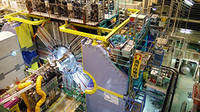 Secrets of the Big Bang and Dark Matter Secrets of the Big Bang and Dark MatterWith Belle II, a globally unique particle accelerator experiment goes into operation in Japan. More26.04.2018 |
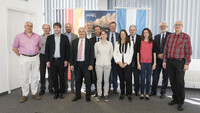 Kick-off event of the new Helmholtz International Research School Kick-off event of the new Helmholtz International Research SchoolOn April 17, 2018 the kick-off event for the Helmholtz International Research School for Astroparticle Physics and Enabling Technologies (HIRSAP) of the Karlsruhe Institute of Technology (KIT) and the Universidad Nacional de San Martín (UNSAM) in Buenos Aires, Argentina, took place at KIT. More |
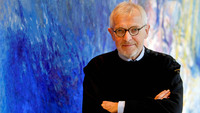 Julius Wess Prize 2017 Goes to Francis Halzen Julius Wess Prize 2017 Goes to Francis HalzenHe received the award for his achievements in astroparticle physics and in the international experiment IceCube. More13.04.2018 |
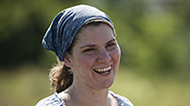 KIT receives Best Teaching Award from Deutsche Geophysikalische Gesellschaft (DGG) KIT receives Best Teaching Award from Deutsche Geophysikalische Gesellschaft (DGG)Ellen Gottschämmer from the Geophysical Institute has been honoured for excellent teaching. More |
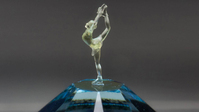 DPG Prize for Superprecise 3D Laser Printing DPG Prize for Superprecise 3D Laser PrintingThe German Physical Society grants a prize to the Institute of Nanotechnology and the Innovation Management Service Unit. More14.02.2018 |
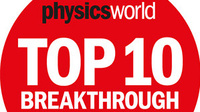 Pierre Auger Collaboration Receives Award Pierre Auger Collaboration Receives AwardThe Pierre Auger Collaboration receives the award Physics World Top Ten Breakthrough of 2017 for their proof of extra- |
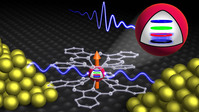 Quantum Computing Enables Fast Database Searches Quantum Computing Enables Fast Database SearchesKIT scientists have implemented Grover’s quantum algorithm for search in unsorted databases. More14.11.2017 |
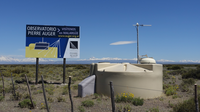 Support of the Helmholtz International Research School on Astroparticle Physics and Enabling Technologies Support of the Helmholtz International Research School on Astroparticle Physics and Enabling TechnologiesThe Helmholtz Association supports three international research schools, among them the International Research School on Astroparticle Physics and Enabling Technologies, applied by Karlsruhe Institute of Technology (KIT) together with Universidad Nacional de San Martín (UNSAM), Buenos Aires. The spokespersons of the Research School, that is expected to start on April 1, 2018, are Dr. Ralph Engel from the German side and Dr. Alberto Etchegoyen from the Argentinian side. More |
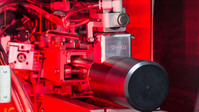 Microscopy: A Keen Eye on Sensitive Samples Microscopy: A Keen Eye on Sensitive SamplesA new multifunctional electron microscope of KIT can detect structures in sensitive materials. More11.10.2017 |
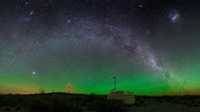 Ambassadors From Distant Galaxies Ambassadors From Distant GalaxiesScientists of the Pierre Auger Collaboration prove extragalactic origin of high-energy cosmic rays. More22.09.2017 |
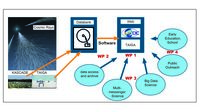 German-Russian Research Group Receives 3 Years of Funding German-Russian Research Group Receives 3 Years of FundingThe Helmholtz Association and the Russian Science Foundation (RSF) have selected the first six joint research groups for their "Helmholtz-RSF Joint Research Groups" funding program, including the Karlsruhe-Russian Astroparticle Data Life Cycle Initiative. The aim of this project is to make publicly available a broad spectrum of data on high-energy cosmic rays. The participating researchers from KIT are Dr. A. Haungs, IKP, and Prof. A. Streit, SCC, and from the Russian side Prof. A Kryukov, MSU. More |
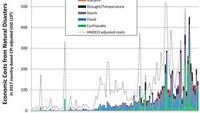 Harvey Is One of the Top 10 Most Costly Natural Disasters Harvey Is One of the Top 10 Most Costly Natural DisastersTexas suffers direct losses of $58 billion, further increases in costs may be expected. Only Sandy and Katrina were more expensive. More31.08.2017 |
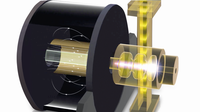 Kompakte Beschleuniger: Mit Terahertz-Licht in die Materie blicken Kompakte Beschleuniger: Mit Terahertz-Licht in die Materie blickenAm 13. Juli fanden die Feierlichkeiten anlässlich der Einweihung des Linear- |
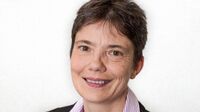 Professor Marlis Hochbruck Has Been Confirmed as Vice President of DFG Professor Marlis Hochbruck Has Been Confirmed as Vice President of DFGProf. Marlis Hochbruck has been elected as vice president for further 4 years by the Joint Committee of Deutsche Forschungs- |
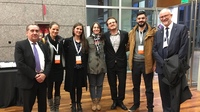 Chancellor Merkel in Dialogue with Doctoral Students of the Double Doctoral degree in Astrophysics (DDAp) Chancellor Merkel in Dialogue with Doctoral Students of the Double Doctoral degree in Astrophysics (DDAp)During the travel of Chancellor Angela Merkel to Argentina on June 8 an exchange with students and young scientists took place concerning cooperations. Doctoral students of the Double Doctoral degree in Astrophysics (DDAp) - a program between KIT and the Universidad Nacional de San Martín (UNSAM) in Buenos Aires - participated in the dialogue. |
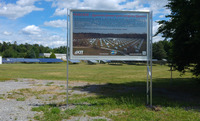 Information Board of the KASCADE/KASCADE-Grande Experiment Information Board of the KASCADE/KASCADE-Grande ExperimentJust in time for the upcoming open day the KASCADE/ KASCADE-Grande information board has been mounted in the southwesterly corner of the former KASCADE detector array at Campus North. The extensive air shower experiment Karlsruhe Shower Core and Array Detector (KASCADE) studied successfully the characteristics of cosmic radiation from February 1994 to January 2013. The KASCADE data are made available for public usage at the KASCADE Cosmic Ray Data Centre (KCDC).
|
Der Teilchenbeschleuniger LHC am europäischen Teilchenphysiklabor CERN bei Genf hat wieder seinen Betrieb aufgenommen. Am CMS-Experiment wurde in der Winterpause ein neuer Silizium-Pixeldetektor eingebaut. Physiker, Ingenieure und Techniker vom Karlsruher Institut für Technologie (KIT) haben dazu an vielen Stellen wichtige Beiträge geleistet. Link_more |
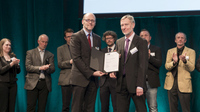 KIT-Fakultätslehrpreis für Prof. Dr. Frank Herrlich KIT-Fakultätslehrpreis für Prof. Dr. Frank HerrlichHerausragende Leistungen in der Lehre würdigt das Präsidium jährlich mit dem KIT-Fakultätslehrpreis. Der Preis ist mir 10.000 Euro dotiert. Bei der Jahresfeier 2017 zeichnete Prof. Alexander Wanner, Vizepräsident für Lehre und akademische Angelegenheiten, Dozentinnen und Dozenten in den elf KIT-Fakultäten aus, darunter Prof. Dr. Frank Herrlich vom Institut für Algebra und Geometrie. |
 Two Researchers of KIT Receive ERC Advanced Grants Two Researchers of KIT Receive ERC Advanced GrantsEuropean Research Council (ERC) selects Wolfgang Wernsdorfer for funding through an ERC Advanced Grant. More |
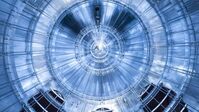 Network for Neutrino Research and Sensors Network for Neutrino Research and SensorsThe international network Neutrino mass develops more precise detectors for particle physics experiments like KATRIN. More |
Robert Klanner was nominated for the 2016 Julius Wess Award in recognition of his fundamental contributions to the development of silicon microstrip detectors. More |
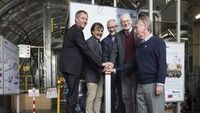 Karlsruhe Tritium Neutrino Experiment (KATRIN): "First Light" Karlsruhe Tritium Neutrino Experiment (KATRIN): "First Light"KATRIN experiment has reached the next major milestone: For the first time, electrons flew through the whole facility to the detector. More |
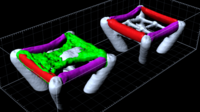 Erwin Schrödinger Award for Specifically Designed Petri Dishes Erwin Schrödinger Award for Specifically Designed Petri DishesThree KIT scientists receive the award worth EUR 50,000 for their interdisciplinary reasearch on three-dimensional cell culturing. More |
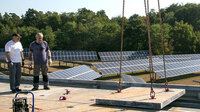 4000 Tonnen KASCADE-Eisenplatten ziehen um zu FAIR 4000 Tonnen KASCADE-Eisenplatten ziehen um zu FAIR |
 Nobel Laureate James W. Cronin Died Nobel Laureate James W. Cronin DiedJames W. Cronin, American physicist and nobel laureate, died August 25, 2016 in Saint Paul, Minnesota, USA, at the age of 84. More |
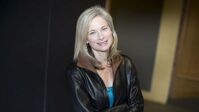 Lisa Randall Receives the 2015 Julius Wess Prize Lisa Randall Receives the 2015 Julius Wess PrizeThe Prize will be handed over to the the theoretical physicist of Harvard University on July 8. More30.06.2016 |
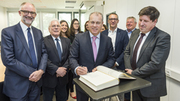 Brazilian State Minister at KIT Brazilian State Minister at KITIn the focus of the visit was a cooperation project with universities in the South of Brazil. More |
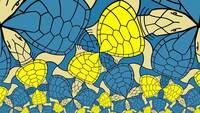 Research Training Group in Asymptotic Geometry Research Training Group in Asymptotic GeometryNew Research Training Group of KIT and the University of Heidelberg will begin its work by October. More24.05.2016 |
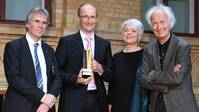 KIT Brings Outstanding Experimental Physicist Back to Germany KIT Brings Outstanding Experimental Physicist Back to GermanyAlexander von Humboldt Professorship awarded to Wolfgang Wernsdorfer, who will conduct research at KIT from June. More04.05.2016 |
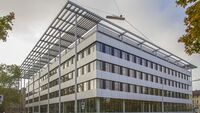 KIT Receives "Deutscher Hochschulbaupreis" KIT Receives "Deutscher Hochschulbaupreis"The restored building on KIT Campus South is an example of sustainable campus architecture. More05.04.2016 |
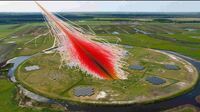 Simulations at KIT Analyze Cosmic Rays Simulations at KIT Analyze Cosmic RaysDeveloped at the KIT, the simulation code CoREAS leads to new insights about cosmic rays. More03.03.2016 |
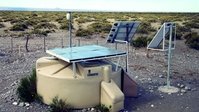 AugerPrime: Looking for Cosmic Rays AugerPrime: Looking for Cosmic Rays |
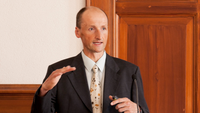 KIT Receives Humboldt Professorship for Physicist KIT Receives Humboldt Professorship for Physicist |
